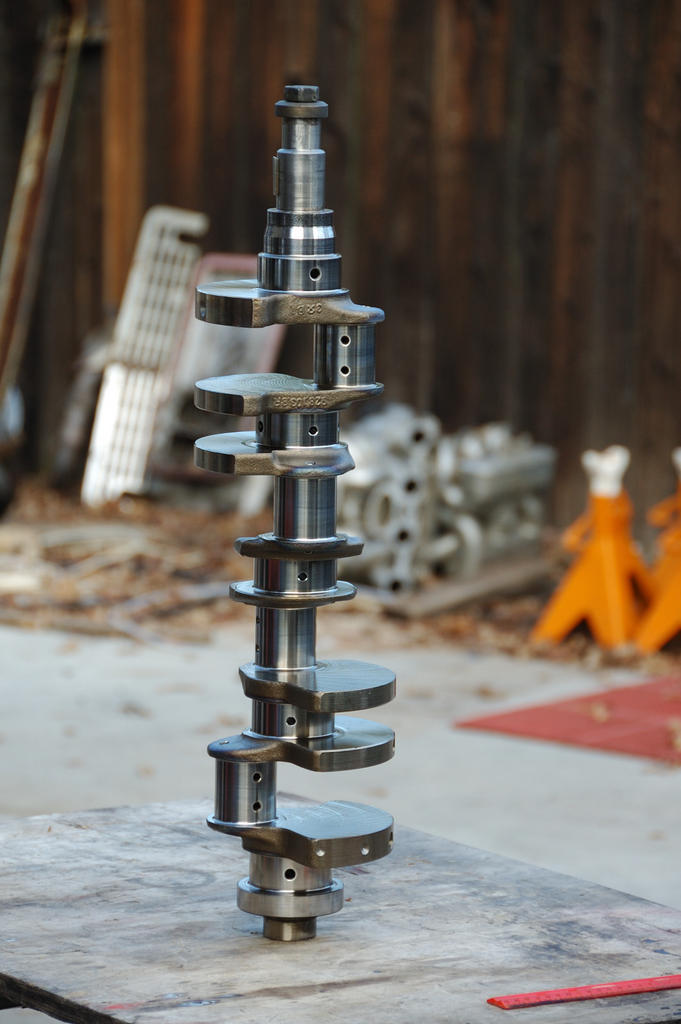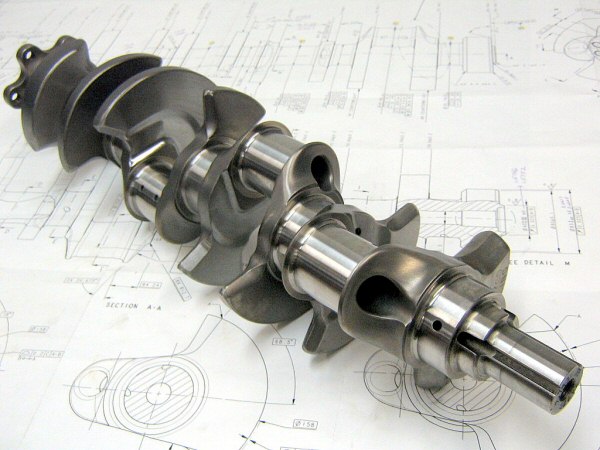GTS vs S4 crankshaft
#1
Nordschleife Master
Thread Starter
Anybody knows what they were thinking when switching from the S4 crankshaft design to GTS crankshaft design? Were they trying to keep the bearing loads the same while increasing the stroke from 78.9mm to 85.9?
S4 crankshaft:

GTS crankshaft:

(Both photos by Dennis Kao).
S4 crankshaft:

GTS crankshaft:

(Both photos by Dennis Kao).
#3
Addict
Rennlist Member
Rennlist Member
People were complaining especially GT engines run rough. Adding two more counterweights was response to that.
Nose was changed to make it stronger.
Nose was changed to make it stronger.
#4
Former Sponsor
Throwing on a bunch of extra weight onto the crank made the engine slower to rev. This wasn't an issue with the GTS, since it was, by then, an uber luxury car. Sure not very good for a "performance" engine.
#5
Nordschleife Master
Thread Starter
But you still tend to see both designs survive, wonder why that is? (By the way, I am not sure abut the terminology, but I think both cranks are "fully counterweighted" or "full-weight counterweighted." If I am wrong about this, please correct me.)
Interesting info.
There's actually two changes that I can see. The first is as you note the extra two counterweights. The second is that the counterweights are clocked at the same angle per end in the S4 crank, whereas the GTS crank counterweights are clocked to be 180 degrees from each crank pin.
I think you see both variations in modern cranks along the first issue. I don't think you see that many modern cranks with all three cws per end clocked in the same angle. I could be wrong, my survey is limited to surfing the web.
It's kind of interesting and sometimes counterintuitive.
I thought that as far as the counterweight design goes, heavier cranks spin faster. The rod journal, rod, piston, etc. are given. The balance is determined by weight times radius. The polar moment of inertia is determined by weight times radius^2. So a heavier design accelerates faster, holding everything else constant.
In this case, not everything else is held constant, of course. The S4 crank has the cws further away from the center main journal than the GTS crank. I think that the purpose of dual plane V8 cws is to cancel the first order imbalance of the crank. If I've understood this correctly, further away the cws are from the center main journal, smaller they can be. So because of this difference the S4 style crank can have both a lower weight and lower polar moment of inertia than the GTS style crank. I've been told that the downside of moving the cws further away from the center main is higher bearing loads -- otherwise if there were no downside why not just externally balance all crankshafts?
I don't think it was just for idle though. At idle, the firing pulses matter more than balance, I think. If it were just the idle, they could have just made the flywheel heavier. Sounds like a much cheaper solution than those extra cws.
There's actually two changes that I can see. The first is as you note the extra two counterweights. The second is that the counterweights are clocked at the same angle per end in the S4 crank, whereas the GTS crank counterweights are clocked to be 180 degrees from each crank pin.
I think you see both variations in modern cranks along the first issue. I don't think you see that many modern cranks with all three cws per end clocked in the same angle. I could be wrong, my survey is limited to surfing the web.
I thought that as far as the counterweight design goes, heavier cranks spin faster. The rod journal, rod, piston, etc. are given. The balance is determined by weight times radius. The polar moment of inertia is determined by weight times radius^2. So a heavier design accelerates faster, holding everything else constant.
In this case, not everything else is held constant, of course. The S4 crank has the cws further away from the center main journal than the GTS crank. I think that the purpose of dual plane V8 cws is to cancel the first order imbalance of the crank. If I've understood this correctly, further away the cws are from the center main journal, smaller they can be. So because of this difference the S4 style crank can have both a lower weight and lower polar moment of inertia than the GTS style crank. I've been told that the downside of moving the cws further away from the center main is higher bearing loads -- otherwise if there were no downside why not just externally balance all crankshafts?
I don't think it was just for idle though. At idle, the firing pulses matter more than balance, I think. If it were just the idle, they could have just made the flywheel heavier. Sounds like a much cheaper solution than those extra cws.
#6
Rennlist Member
IIRC there are two stroker race cars that were close to identical one with 6 counterweights and one with eight. The one with eight had more horsepower, the one with 6 accelerated more quickly.
#7
Nordschleife Master
Thread Starter
The car accelerated quicker with the gear on or the engine accelerated quicker without load?
Trending Topics
#8
Race Director
#9
Rennlist Member
#10
Nordschleife Master
Thread Starter
So can someone explain to me like to six year old how the middle two counterweights are any more useful than my love handles, given that they are so close to the center main? Do they reduce the crank flexing and therefore bearing loads? Or what do they do?
#11
Race Director
This makes for a more ideal balancing of the rotating assembly.....for smoother operation and the ability to spin higher RPM.....however for the RPM a 6 weight crank 928 engine was designed, its fine....its not until the higher HP-RPM ranges that the vibrations become detrimental to the engine
For example in the mid 90's when Bob Devore was designing the 1st 928 strokers he built cranks with 6 counterweights (since thats what Porsche used)...but after breaking a couple cranks and blocks, he went to the 8 weight design.....
If the 8 weight crank is heavier, then sure it will spin slower.....but if its built to the same weight...why not do it
#12
Nordschleife Master
Thread Starter
For the acceleration, it is my impression that it's important how much heavy metal is used in the cw design. More heavy metal added, faster the acceleration. The other important thing is how far the cws are from the center main, further away they are, faster the acceleration.
#13
Rennlist Member
Contemporary Crankshaft Design
THIS IS A MODIFIED VERSION OF AN ARTICLE
BY Jack Kane WHICH APPEARED IN ISSUE 033 of
RACE ENGINE TECHNOLOGY MAGAZINE
THIS IS A MODIFIED VERSION OF AN ARTICLE
BY Jack Kane WHICH APPEARED IN ISSUE 033 of
RACE ENGINE TECHNOLOGY MAGAZINE
One stiffness area where most two-plane V8 engine people agree is the use of center counterweights. It has been known for some time that there are significant power gains available in two-plane crank V8s from the use of counterweights around the center main bearing
Traditionally, many two-plane V8 crankshafts had been produced without center counterweights because of economies and difficulties forging the blanks, because the six-counterweight crank typically has a slightly lower MMOI, and because the benefits of an eight-counterweight crank in a short-stroke application were not fully appreciated. However, the bending deflection across the center main at high loadings and high speeds causes measurable losses, so many areas of racing which use two-plane V8 cranks are moving (or have already moved) to eight-counterweight cranks. From an overall engine design perspective, the relocation of the thrust bearing from the rear main to the center main also helps reduce center-main bending deflection.
Traditionally, many two-plane V8 crankshafts had been produced without center counterweights because of economies and difficulties forging the blanks, because the six-counterweight crank typically has a slightly lower MMOI, and because the benefits of an eight-counterweight crank in a short-stroke application were not fully appreciated. However, the bending deflection across the center main at high loadings and high speeds causes measurable losses, so many areas of racing which use two-plane V8 cranks are moving (or have already moved) to eight-counterweight cranks. From an overall engine design perspective, the relocation of the thrust bearing from the rear main to the center main also helps reduce center-main bending deflection.
#14
Nordschleife Master
Thread Starter
In any case, the article shows a picture of crankshaft with 8 cws. So they help with stiffness, and thereby with bearing loads. However, the center cws at least appear to be much smaller than other cws. This is in contrast with the GTS crank cws that appear to be about as large as most other cws and only slightly smaller than the end cws.

Not sure that the photo is of a modern, expensive crank though. I can't see heavy metal anywhere, and if one cares about polar moment of inertia, then one should have heaviest material available in those cws.
#15
Rennlist Member
 HP will tell all from the dyno, BUT, in neutral, there could be a slight diffrence. an indication of that , might be a 1st gear dyno run, but that is hardly done, ever. more hp will yeild more hp in even neutral for 99% of the times you test it. my 6.5 liter will rev, in neutral, much faster or at least the same, as my S4 crank with only 30 more HP.
HP will tell all from the dyno, BUT, in neutral, there could be a slight diffrence. an indication of that , might be a 1st gear dyno run, but that is hardly done, ever. more hp will yeild more hp in even neutral for 99% of the times you test it. my 6.5 liter will rev, in neutral, much faster or at least the same, as my S4 crank with only 30 more HP. 


